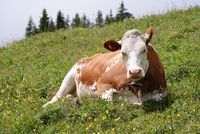Cattle
Cattle
Cattle (Bos taurus) are large, domesticated, bovid ungulates widely kept as livestock. They are prominent modern members of the subfamily Bovinae and the most widespread species of the genus Bos. Mature female cattle are called cows, and mature male cattle are bulls. Young female cattle are called heifers, young male cattle are oxen or bullocks, and castrated male cattle are known as steers.
Cattle are commonly raised for meat, for dairy products, and for leather. As draft animals, they pull carts and farm implements. In India, cattle are sacred animals. Small breeds, such as the miniature Zebu, are kept as pets.
Taurine cattle are widely distributed across Europe and temperate areas of Asia, the Americas, and Australia. Zebus are found mainly in India and tropical areas of Asia, America, and Australia. Sanga cattle are found primarily in sub-Saharan Africa. These types, sometimes classified as separate species or subspecies, are further divided into over 1,000 recognized breeds.
Around 10,500 years ago, taurine cattle were domesticated from wild aurochs progenitors in central Anatolia, the Levant, and Western Iran. A separate domestication event occurred in the Indian subcontinent, which gave rise to zebu. In 2022, there were over 940 million cattle in the world. Cattle are responsible for around 10% of global greenhouse gas emissions. Cattle were one of the first domesticated animals to have a fully mapped genome.
Economy
Meat
The meat of adult cattle is known as beef, and that of calves is veal. Other animal parts are used as food products, including blood, liver, kidney, heart and oxtail. Approximately 300 million cattle, including dairy animals, are slaughtered each year for food. About a quarter of the world's meat comes from cattle. World cattle meat production in 2021 was 72.3 million tons.
Dairy
Certain breeds of cattle, such as the Holstein-Friesian, are used to produce milk, much of which is processed into dairy products such as butter, cheese, and yogurt. Dairy cattle are usually kept on specialized dairy farms designed for milk production. Most cows are milked twice per day, with milk processed at a dairy, which may be onsite at the farm or the milk may be shipped to a dairy plant for eventual sale of a dairy product.[100] Lactation is induced in heifers and spayed cows by a combination of physical and psychological stimulation, by drugs, or by a combination of those methods. For mother cows to continue producing milk, they give birth to one calf per year. If the calf is male, it generally is slaughtered at a young age to produce veal. They will continue to produce milk until three weeks before birth. Over the last fifty years, dairy farming has become more intensive to increase the yield of milk produced by each cow. The Holstein-Friesian is the breed of dairy cow most common in the UK, Europe and the United States. It has been bred selectively to produce the highest yields of milk of any cow. Around 22 litres per day is average in the UK.
Dairy is a large industry worldwide. In 2023, the 27 European Union countries produced 143 million tons of cow's milk; the United States 104.1 million tons; and India 99.5 million tons. India further produces 94.4 million tons of buffalo milk, making it (in 2023) the world's largest milk producer; its dairy industry employs some 80 million people.
Draft animals
Oxen are cattle trained as draft animals. Oxen can pull heavier loads and for a longer period of time than horses.[106] Oxen are used worldwide, especially in developing countries. There are some 11 million draft oxen in sub-Saharan Africa, while in 1998, India had over 65 million oxen. At the start of the 21st century, about half the world's crop production depended on land preparation by draft animals.
Hides
Cattle are not often kept solely for hides, and they are usually a by-product of beef production. Hides are used mainly for leather products such as shoes. In 2012, India was the world's largest producer of cattle hides. Cattle hides account for around 65% of the world's leather production.
Since the raising of cattle is so prevalent, the amount of leather processed is quite high, and the prices per square foot are low.
| Articles related to leather working | |
|---|---|
| See also: |
|
| Types | |
| Substitutes | |
| Leather sources |
|
| Processes |
|
| Crafting |
|
| Hardware | |
| Tools | |
| Leather museums | Leather Archives and Museum |
| Related | |
External links
- More information is available at [ Wikipedia:Cattle ]
Chat rooms • What links here • Copyright info • Contact information • Category:Root
